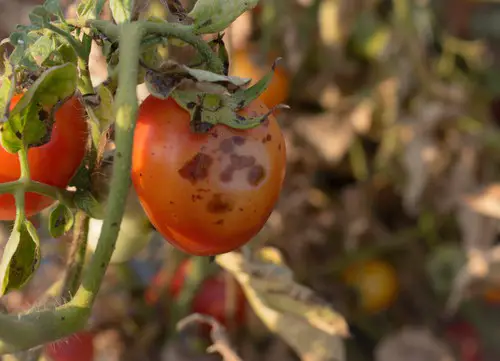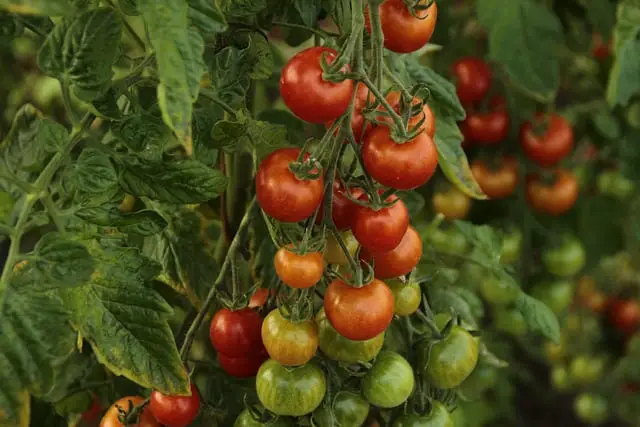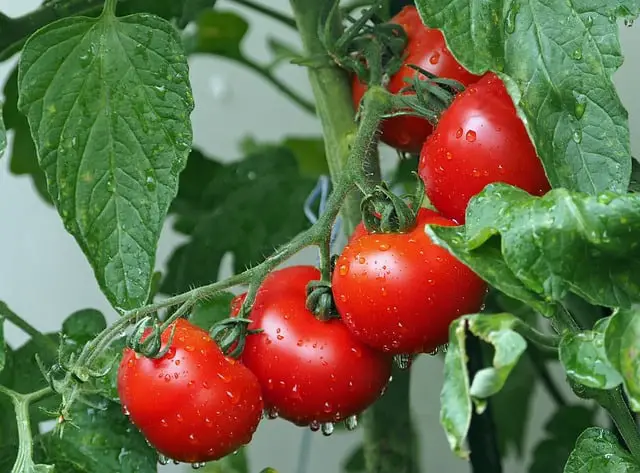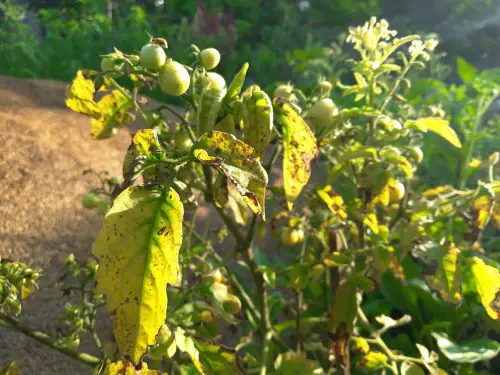Tomato plants with yellow leaves and black spots are a common sight in many gardens. These symptoms are an indication that something is wrong with the plant, and it needs attention. Yellow leaves and black spots can be caused by a variety of factors, including fungal infections, nutrient deficiencies, and environmental factors.
Understanding the causes of yellow leaves and black spots on tomato plants is crucial to finding the right solution. If left untreated, the condition can spread to other parts of the plant and even affect the yield.
Environmental factors, such as temperature, humidity, and light, can play a significant role in the development of this condition. Nutrient deficiencies, such as lack of nitrogen, magnesium, or calcium, can also cause yellow leaves and black spots on tomato plants.
Key Takeaways
- Yellow leaves with black spots on tomato plants are a sign that something is wrong with the plant.
- The condition can be caused by various factors, including fungal infections, nutrient deficiencies, and environmental factors.
- Understanding the causes of yellow leaves and black spots is crucial to finding the right solution and avoiding damage to the plant and yield.
Also read:
- Black Spots on Tomato Plant Leaves
- Tiny Black Spots on Succulent Leaves
- Tiny Black Spots on Fan Leaves
Understanding Yellow Leaves and Black Spots on Tomato Plants

Yellow leaves and black spots on tomato plants are a common problem for gardeners and can be caused by a variety of factors. Understanding the causes of these symptoms is important for effectively treating and preventing further damage to the plant.
One of the most common causes of yellow leaves on tomato plants is a lack of water. When a tomato plant is not getting enough water, the leaves will begin to turn yellow and eventually die. Overwatering can also cause yellow leaves, as it can lead to root rot and other fungal diseases.
Black spots on tomato leaves can be caused by a number of fungal diseases, including early blight, Septoria leaf spot, and Fusarium wilt. These diseases can be identified by the appearance of black or brown spots on the leaves, which can eventually cause the leaves to wither and die.
Preventing yellow leaves and black spots on tomato plants involves proper watering and regular maintenance. Gardeners should ensure that their plants are getting enough water, but not too much, and that the soil is well-draining. They should also remove any infected leaves or plants to prevent the spread of disease.
In addition to proper watering and maintenance, gardeners can also use fungicides and other treatments to prevent and control fungal diseases on their tomato plants. By understanding the causes of yellow leaves and black spots on tomato plants, gardeners can take steps to ensure the health and vitality of their plants.
Tomato Plants with Yellow Leaves and Black Spots – 5 Common Problems
Yellow leaves with black spots are a common problem in tomato plants. This section will cover the most common causes of this issue.
1. Fungal Disease
Fungal diseases are among the most common causes of yellow leaves with black spots on tomato plants. Three common fungal diseases that contribute to this problem are Fusarium wilt, early blight, and Septoria leaf spot.
Fusarium wilt causes older leaves to turn yellow and eventually turn black. Leaves then fall off. Early blight causes yellowing of the lower leaves, which then develop black spots. The leaves may eventually die and fall off. Septoria leaf spot causes yellow spots on the leaves, which then develop black spots in the center.
2. Bacterial Disease

Bacterial diseases can also cause yellow leaves with black spots on tomato plants. Late blight is a bacterial disease that can cause yellowing of the leaves, which then develop black spots. The disease can spread quickly and cause the plant to wilt and die.
Bacterial spot is another disease that can cause yellowing of the leaves and the development of black spots.
3. Nutrient Deficiency
Nutrient deficiencies can also cause yellow leaves with black spots on tomato plants. A lack of nitrogen, for example, can cause yellowing of the leaves. A lack of calcium can cause the development of black spots on the fruit and leaves.
4. Pests
Pests can also cause yellow leaves with black spots on tomato plants. The tomato fruitworm and the tobacco hornworm are two pests that can cause this problem. These pests can cause damage to the leaves and fruit, which can lead to yellowing and the development of black spots.
5. Environmental Factors
Environmental factors can also contribute to yellow leaves with black spots on tomato plants. Overwatering, for example, can cause the roots to rot, which can lead to yellowing of the leaves. High humidity can also contribute to the development of fungal diseases, which can cause yellowing and black spots.
Environmental Factors Influencing the Condition
Yellow leaves with black spots on tomato plants can be caused by various environmental factors. Here are some of the most common factors that can influence the condition:
1. Watering
Watering is a critical factor in the growth of tomato plants. Overwatering or underwatering can cause yellow leaves with black spots. When the soil is too wet, it can lead to root rot, which can cause yellowing of the lower leaves. On the other hand, when the soil is too dry, the plant can become stressed, leading to yellowing of the leaves.
2. Soil
The soil in which the tomato plant is grown can also have an impact on the development of yellow leaves with black spots. If the soil is too acidic, it can cause yellowing of the leaves.
Similarly, if the soil is too alkaline, it can also lead to yellowing of the leaves. It is essential to ensure that the soil has the right balance of nutrients to prevent yellowing of the leaves.
3. Humidity

Humidity can also be a factor in the development of yellow leaves with black spots. High humidity can lead to the growth of fungal diseases, which can cause yellowing of the leaves. It is essential to ensure that the humidity levels are kept in check to prevent the growth of these diseases.
4. Weather
The weather can also play a significant role in the development of yellow leaves with black spots. For instance, if the weather is warm and humid, it can lead to the growth of fungal diseases, such as early blight and Septoria leaf spot.
These diseases can cause yellowing of the leaves, starting from the lower leaves, and then spreading to the upper leaves.
5. Sunscald
Sunscald is another environmental factor that can cause yellowing of the leaves. This condition occurs when the plant is exposed to too much sunlight, leading to damage to the leaves. The leaves will turn tan or white, and then eventually yellow.
6. Season
The season in which the tomato plant is grown can also have an impact on the development of yellow leaves with black spots. For instance, if the plant is grown during the rainy season, it can lead to the growth of fungal diseases, which can cause yellowing of the leaves.
Similarly, if the plant is grown during the cool season, it can lead to stress on the plant, which can also cause yellowing of the leaves.
7. Stems
Yellowing of the leaves can also be caused by damage to the stems of the plant. If the stem is damaged, it can affect the flow of nutrients to the leaves, leading to yellowing of the leaves.
Nutrient Deficiencies Leading to Yellow Leaves and Black Spots
Yellow leaves with black spots are a common problem for tomato plants. Nutrient deficiencies are one of the main causes of this issue. When plants do not get enough nutrients, they cannot grow properly and become more susceptible to diseases and pests.
Here are some of the most common nutrient deficiencies that can lead to yellow leaves with black spots:
1. Nitrogen Deficiency

Nitrogen is one of the most important nutrients for plant growth and development. It is responsible for the production of chlorophyll, which gives plants their green color.
When plants do not get enough nitrogen, their leaves turn yellow and become stunted. In tomato plants, nitrogen deficiency can also cause the undersides of leaves and stems to develop a purple coloration.
2. Iron Deficiency
Iron is another essential nutrient for plant growth. It is involved in the production of chlorophyll and helps plants to absorb other nutrients. When plants do not get enough iron, their leaves turn yellow and develop black spots. Iron deficiency is more common in alkaline soils, where iron is less available to plants.
3. Potassium Deficiency
Potassium is important for plant growth and helps to regulate water balance and nutrient uptake. When plants do not get enough potassium, their leaves turn yellow and develop black spots. In tomato plants, potassium deficiency can also cause the edges of leaves to curl and become brown.
4. Magnesium Deficiency
Magnesium is involved in the production of chlorophyll and helps plants to absorb other nutrients. When plants do not get enough magnesium, their leaves turn yellow and develop black spots. Magnesium deficiency is more common in acidic soils, where magnesium is less available to plants.
Preventive Measures and Solutions
When it comes to preventing and treating yellow leaves with black spots on tomato plants, there are several measures that can be taken.
One of the most important steps is to ensure proper watering. Overwatering can lead to fungal growth, while underwatering can cause stress and yellowing of the leaves. It is recommended to water tomato plants at the base of the plant using drip irrigation or a soaker hose to avoid wetting the leaves.
Another important factor is good air circulation. Proper spacing between plants, pruning, and removing any diseased leaves can help promote airflow and reduce the risk of fungal growth.
Mulching around the base of the plants with organic materials such as compost can help retain moisture and prevent soil-borne diseases. Additionally, fertilizing with a balanced fertilizer that is high in potassium can help strengthen the plants and improve disease resistance.
Crop rotation is also a key preventative measure. Avoid planting tomatoes in the same location for at least three years to reduce the risk of soil-borne diseases.
If yellow leaves with black spots are already present, it is important to act quickly to prevent further spread. Fungicides such as chlorothalonil, mancozeb, and sulfur can be effective in treating fungal diseases. However, it is important to follow the instructions carefully and avoid overuse, as this can lead to resistance.
In addition to fungicides, there are also organic options such as potassium bicarbonate that can be effective in treating fungal diseases. However, prevention is always the best approach, and choosing resistant tomato varieties can help reduce the risk of disease altogether.
Impact on Tomato Fruits and Yield

Yellow leaves and black spots on tomato plants can significantly impact the health and yield of the tomato fruits. When the leaves turn yellow, the plant is unable to produce enough chlorophyll, which is necessary for photosynthesis and the production of energy.
As a result, the plant may not be able to produce enough energy to support the growth and development of the tomato fruits.
In addition to the lack of energy production, black spots or lesions on the leaves can also indicate the presence of diseases such as bacterial spot or late blight. These diseases can cause the leaves to wilt and eventually die, which can lead to a reduction in the overall health and yield of the tomato plant.
When the tomato plant is not producing enough energy, it may also be unable to support the growth of new fruits. This can lead to a reduction in the number of tomato fruits that are produced, as well as a decrease in the size and quality of the fruits that do grow.
Furthermore, if the tomato plant is infected with a disease that causes wilting, such as bacterial wilt or fusarium wilt, the entire plant may die before the fruits are ready to be harvested. This can result in a complete loss of the tomato crop for that season.
Role of Gardening Practices in Avoiding Yellow Leaves and Black Spots
Gardeners can take several measures to avoid yellow leaves and black spots on their tomato plants. Proper gardening practices can help prevent the development and spread of fungal diseases, which are the primary cause of these symptoms.
One important practice is to remove weeds and plant debris from the garden. Weeds can harbor fungal spores and provide a breeding ground for pests, which can spread the disease to healthy plants. Plant debris left on the ground can also harbor fungal spores and provide a breeding ground for pests.
Overwintering tomato plants can also contribute to the development of fungal diseases. Overwintered plants are more susceptible to diseases and pests, as they are weakened by the stress of winter weather. Gardeners should consider planting new tomato plants each year to avoid this problem.
Air circulation is another important factor in preventing fungal diseases. Tomato plants need good air circulation to help prevent the buildup of moisture on the leaves, which can lead to the development of fungal diseases. Gardeners should avoid overcrowding their plants and use proper staking techniques to ensure good air circulation.
Proper watering practices are also important in preventing yellow leaves and black spots. Overwatering can lead to root rot, which can weaken the plant and make it more susceptible to fungal diseases. Gardeners should water their plants deeply and less frequently, rather than giving them frequent shallow waterings.
Gardeners should also be careful when using gardening tools, as they can spread fungal diseases from plant to plant. Tools should be cleaned and disinfected between uses to prevent the spread of disease.
Finally, gardeners should be vigilant for signs of pests and diseases, and take appropriate action to prevent their spread. This may include removing infected plants, treating with fungicides or pesticides, or using natural pest control methods.
By following these gardening practices, gardeners can help prevent yellow leaves and black spots on their tomato plants and enjoy a healthy and abundant harvest.
Frequently Asked Questions

What causes black spots on tomato leaves?
Black spots on tomato leaves are typically caused by fungal infections, such as early blight or Septoria leaf spot. These infections can spread rapidly and cause the leaves to yellow and die, ultimately affecting the overall health of the plant.
It is important to identify the cause of the black spots early on and take action to prevent further spread.
How do I treat tomato plants with yellow leaves?
Yellow leaves on tomato plants can be a sign of a variety of issues, including nutrient deficiencies, overwatering, or disease. To treat yellow leaves, first identify the cause of the issue and address it accordingly.
For example, if the yellowing is due to overwatering, reduce the amount of water the plant receives. If it is due to a nutrient deficiency, fertilize the plant with the appropriate nutrients.
What are the signs of Verticillium wilt in tomato plants?
Verticillium wilt is a fungal disease that affects tomato plants and can cause yellowing and wilting of the leaves. Other symptoms include stunted growth, brown streaks on the stems, and a general decline in the health of the plant.
Once a plant is infected with Verticillium wilt, it is difficult to treat. The best course of action is to remove the infected plant and avoid planting tomatoes in the same area for several years.
How do I prevent Fusarium wilt in my tomato plants?
Fusarium wilt is another fungal disease that affects tomato plants and can cause yellowing, wilting, and stunted growth.
To prevent Fusarium wilt, it is important to plant disease-resistant varieties of tomatoes and to rotate crops each year. It is also important to avoid overwatering and to maintain proper soil drainage.
What is the best treatment for powdery mildew on tomato plants?
Powdery mildew is a fungal disease that can affect tomato plants and cause a white, powdery coating on the leaves. To treat powdery mildew, remove any infected leaves and treat the plant with a fungicide.
It is also important to maintain proper air circulation around the plant and to avoid overwatering.
How can I prevent Septoria leaf spot on my tomato plants?
Septoria leaf spot is a fungal disease that can cause black spots on tomato leaves and ultimately lead to yellowing and death of the plant.
To prevent Septoria leaf spot, it is important to plant disease-resistant varieties of tomatoes and to maintain proper spacing between plants to promote air circulation. It is also important to avoid overhead watering and to remove any infected leaves promptly.

Hey, I’m Lisa and I’ve been an avid gardener for over 30 years. I love writing, talking and living in the garden! Feel free to connect with me on my socials below


